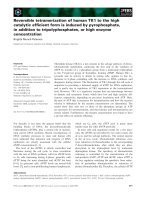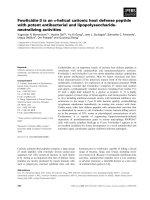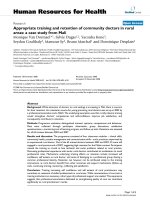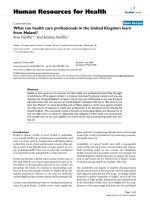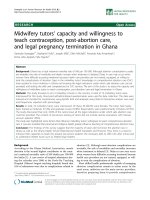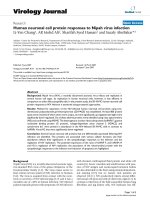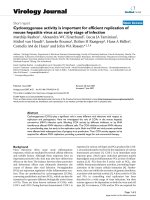Báo cáo sinh học: " Thottapalayam virus is genetically distant to the rodent-borne hantaviruses, consistent with its isolation from the Asian house shrew (Suncus murinus)" potx
Bạn đang xem bản rút gọn của tài liệu. Xem và tải ngay bản đầy đủ của tài liệu tại đây (279.21 KB, 5 trang )
BioMed Central
Page 1 of 5
(page number not for citation purposes)
Virology Journal
Open Access
Short report
Thottapalayam virus is genetically distant to the rodent-borne
hantaviruses, consistent with its isolation from the Asian house
shrew (Suncus murinus)
Pragya D Yadav
1,2
, Martin J Vincent
1
and Stuart T Nichol*
1
Address:
1
Special Pathogen Branch, Division of Viral and Rickettsial Diseases, National Center for Zoonotic, Vector-borne, and Enteric Diseases,
Centers for Disease Control and Prevention, Atlanta, GA 30333, USA and
2
Microbial Containment Complex, National Institute of Virology, 130/
1 Sus Road, Pashan, Pune 21, Maharashtra 411021, India
Email: Pragya D Yadav - ; Martin J Vincent - ; Stuart T Nichol* -
* Corresponding author
Abstract
Thottapalayam (TPM) virus belongs to the genus Hantavirus, family Bunyaviridae. The genomes of
hantaviruses consist of three negative-stranded RNA segments (S, M and L) encoding the virus
nucleocapsid (N), glycoprotein (Gn, Gc), and polymerase (L) proteins, respectively. The genus
Hantavirus contains predominantly rodent-borne viruses, with the prominent exception of TPM
virus which was isolated in India in 1964 from an insectivore, Suncus murinus, commonly referred
to as the Asian house shrew or brown musk shrew. Analysis of the available TPM virus S (1530 nt)
RNA genome segment sequence and the newly derived M (3621 nt) and L (6581 nt) segment
sequences demonstrate that the entire TPM virus genome is very unique. Remarkably high
sequence differences are seen at the nucleotide (up to S – 47%, M – 49%, L – 38%) and protein (up
to N – 54%, Gn/Gc – 57% and L – 39%) levels relative to the rodent-borne hantaviruses, consistent
with TPM virus having a unique host association.
Findings
Almost all hantaviruses (genus Hantavirus, family Bunya-
viridae) are vectored by murid rodents of the Murinae,
Arvicolinae, and Sigmodontinae subfamilies [1-3]. Hemor-
rhagic fever with renal syndrome (HFRS) is associated
with infection by Murinae- and Arvicolinae-associated
hantaviruses (e.g. Hantaan, Seoul and Puumala viruses)
and hantavirus pulmonary syndrome (HPS) is associated
with Sigmodontinae-associated hantaviruses (e.g. Sin
Nombre and Andes viruses). Humans are infected by
inhalation of aerosolized secreta or excreta from chroni-
cally infected rodents. As the molecular phylogeny of the
rodent-borne hantaviruses largely mirrors the evolution-
ary history of their specific rodent hosts, these viruses are
thought to have evolved over 10s of millions of years by
co-speciation with their specific rodent hosts [1-4].
Despite being the first hantavirus isolated [5], Thotta-
palayam (TPM) virus remains something of an enigma, in
that it was isolated not from a rodent, but from an insec-
tivorous Asian house shrew or musk shrew (Suncus muri-
nus) captured near Vellore, Tamil Nadu, India in1964.
Later it was identified as a hantavirus based on electron
microscopy morphology and cross-reactive serology [5-7].
However, TPM virus has to been shown to be the most
antigenically distinct of all the hantaviruses [7,8]. In addi-
tion, the phylogenetic analysis of a small region of the S
segment of TPM virus showed high divergence compared
to other hantaviruses, suggestive of a unique reservoir
Published: 21 August 2007
Virology Journal 2007, 4:80 doi:10.1186/1743-422X-4-80
Received: 27 July 2007
Accepted: 21 August 2007
This article is available from: />© 2007 Yadav et al; licensee BioMed Central Ltd.
This is an Open Access article distributed under the terms of the Creative Commons Attribution License ( />),
which permits unrestricted use, distribution, and reproduction in any medium, provided the original work is properly cited.
Virology Journal 2007, 4:80 />Page 2 of 5
(page number not for citation purposes)
host [9]. No further virus isolates have been obtained, and
it remains unclear whether the Asian house shrew is the
TPM virus primary reservoir or merely represents a spillo-
ver infection from some unidentified rodent host. To bet-
ter characterize the virus and its relationship to other
hantaviruses, a study to determine the complete genome
of TPM virus was initiated.
TPM virus (strain VRC 66412) was grown in Vero E6 cells
and harvested 12 days post-infection. Virus was inacti-
vated in Tripure (Roche) and RNA isolated using the
RNaid kit (Bio 101). The complete S segment sequence of
TPM virus had been deposited in Genbank earlier by Song
and colleagues (Genbank:AY526097
). Alignment of the
TPM virus S segment sequence with those of known
hantaviruses allowed examination of conserved 3' and 5'
RNA terminal sequences which could be used as the basis
for PCR primer design to attempt to amplify the TPM virus
M and L segment sequences. Following optimization of
RT-PCR primers and reaction conditions, PCR products
representing the entire TPM virus M (3621 bp) and L
(6581 bp) RNA genome segments were successfully pro-
duced in single step RT-PCR reactions using the Super-
script III single step RT-PCR system with Platinum Taq
High fidelity (Invitrogen) according to the manufacturer's
instructions. The newly designed primers included TPM-
M-F1 (5'-TAGTAGTAGACTCCGCA-3) and TPM-M-R3684
(5'-TAGTAGTATRCTCCGCARG-3), and HANTA-L-F2, (5'-
TAGTAGTAGACTCCGGAAG-3') and HANTA-L-R6577
(5'-TAGTAGTATGCTCCGRGAA-3') for M and L segment
amplifications, respectively. The M segment RT reaction
was performed at 50°C for 30 minute and PCR was per-
formed at 94°C for 2 min, followed by 40 cycles of 94°C
for 15 sec, 50°C for 30 sec, 68°C for 4 min, and a final
extension at 68°C for 4 min. L segment reactions utilized
identical conditions, except for 8 minute 68°C extension
times. The amplified DNA products were separated on
agarose gels, and recovered using Nucleotrap gel extrac-
tion kits (Clone Tech Lab). Cycle sequencing employed
ABI Big-Dye 3.1 dye chemistry (Applied Biosystems, Fos-
ter City, CA) at 96°C -1 min, 96°C -10 sec, 45°C -5 sec
and 60 °C -4 min for 25 cycles and resulting products
were purified using Dyex 3.0 (Qiagen). Nucleotide
sequence analysis via primer walking across these PCR
products allowed the completion of the entire TPM virus
genome sequence. Both DNA strands were sequenced and
chromatogram data were assembled using Sequencher
4.1.4 software (Accelrys Inc.). Details of sequencing prim-
ers are available on request. The TPM virus complete M
and L segment sequences have been made available [Gen-
bank: DQ825770
–DQ825771].
The successful completion of the TPM virus genome
sequence allowed comparison with the genomes of the
rodent-borne hantaviruses, and demonstrated that TPM
virus is the most genetically unique of all of the previously
characterized hantaviruses. The TPM virus RNA segment
nucleotide sequences differ from those of the other hanta-
viruses by 44.2–47.1 %, 46.8–49.2 %, and 37.0–38.0 %
for the S, M and L segments, respectively. Deduced amino
acid divergence was also very high, with 50.8–54.5 %,
54.9–57.2 %, and 37.6–38.9% identity differences found
for the N, Gn/Gc and L proteins, respectively. Interest-
ingly, TPM virus appears to be equally distant from the
three main groups of hantaviruses associated with murid
Murinae, Arvicolinae and Sigmodontinae subfamilies (Fig.
1). Despite the high differences observed, TPM virus dis-
plays many of the features common in the rodent-borne
hantaviruses. For instance the S, M and L RNA segment
lengths of 1530, 3621 and 6581 nucleotides, respectively,
and the size of the ORFs and encoded proteins are all typ-
ical of those seen for the other hantaviruses.
Following the N ORF, the TPM virus S segment contains a
highly variable long non-coding region similar to that
seen in many hantaviruses, although the sequence diver-
sity and length variation is such that these regions cannot
be accurately aligned relative to the other hantaviruses. In
terms of coding region, the N protein central region is
highly conserved. This region has been shown to contain
the RNA binding domain, which in the case of HTN virus
has been mapped to a minimal region spanning amino
acids 194–204 [10]. Studies of several hantaviruses have
implicated the amino- and carboxy-termini in N protein
interactions, and although the N protein amino-terminus
of TPM virus is highly divergent relative to that of the
other hantavirues, it is still predicted to form an anti-par-
allel coiled coil structure which is thought to be important
in triggering N protein trimerization [11-13].
The M genome segment 3365 nucleotide long single ORF
(position 40–3405) is predicted to encode a glycoprotein
precursor of approximately 126 kDa. The overall structure
appears similar to that of other hantaviruses, with approx-
imate alignment of hydrophobic domains corresponding
to signal peptide, and Gn and Gc transmembrane
domains (data not shown). While most hantavirus glyco-
proteins have 5–7 predicted N-glycosylations sites, four
potential N-glycosylation sites are conserved among all
hantaviruses, three in Gn (e.g. amino acids 142, 357 and
409 in PUUV) and one in Gc (937 in PUUV) [14]. The
TPM virus glycoprotein is predicted to contain 6 potential
N- linked glycosylation sites, five sites in Gn and one in
Gc, at aa positions 134, 289, 388, 505, 585, and 916. In
general, the N glycosylation sites are highly conserved
among hantaviruses and seem to be crucial for the confor-
mation and function of the proteins which includes the
proper transport, receptor binding and antigenicity [15].
The TPM virus glycoprotein also contains the previously
identified WAASA amino acid motif (aa 633–637) which
Virology Journal 2007, 4:80 />Page 3 of 5
(page number not for citation purposes)
Phylogenetic relationship of TPM virus relative to representatives of the rodent-borne hantavirusesFigure 1
Phylogenetic relationship of TPM virus relative to representatives of the rodent-borne hantaviruses. Hantavirus
sequences were aligned using the PILEUP program of the Wisconsin Package version 10.2 (Accelerys, Inc.) and phylogenetic
analysis performed using PAUP 4.0b10 (Sinauer Association Inc., Sunderland, MA). Nucleotide sequences were analyzed by
maximum likelihood method and maximum parsimony method was used for amino acids. Bootstrap confidence intervals were
calculated using 500 heuristic search replicates. S segment sequence sources are: Hantaan (HTN) virus 76–118 M14626, Bayou
(BAY) L36929, Black Creek Canal (BCC) virus l39949, Laguna Negra (LN) virus AF005727
, Sin Nombre (SN) virus NM H10
L25784, New York (NY) virus RI-1 U09488, EI Moro Canyon (ELMC) virus RM97 U11427, Tula/Moravia/5302/95 Z69991,
Puumala (PUU) virus Sotkamo X161036, PUU virus/Umea/hu NC_005224
, Isla Vista (ISLA) virus U31534, Saaremaa virus 160V
AJ009773
, Dobrava (DOB) virus Ano-Poroia/Afl9/1999 AJ410615, Soochong virus SC-1 AY675349, Seoul (SEO) virus 80–39
AY273791
, Hantavirus Thailand 741 AB288299, Topografov AJ011646, Andes virus CHI-7913 AY228237 and Thottapalayam
(TPM) virus AY526097
. M segment sources are: HTN virus 76–118, Bayou (BAY) L36930, BCC virus l39950, LN virus
AF005728
, SN virus NM H10 L25783, NY virus RI-1 U36801, ELMC virus RM97 U11428, Tula/Moravia/5302/95 Z69993, PUU
virus Sotkamo X161034, PUU virus/Umea/hu NC_005223
, Saaremaa virus160V AJ009774, DOB virus Ano-Poroia/Afl9/1999
AJ410616
, Soochong virus SC-1 AY675353, SEO virus 80–39 S47716, Thailand 749 L08756, Topografov AJ011647, Andes virus
CHI-7913 AY228238
and TPM virus. L segment sources are: HTN virus 76–118 X55901, SN virus NM H10 L37901, Tula/
Moravia/5302/95 NC_005226, Puumala Sotkamo NC_005225
, Puumala virus/Umea/hu AY526217, Saaremaa virus 160V
AJ410618
, DOB virus Ano-Poroia/Afl9/1999 AJ410617, Soochong virus SC-1 DQ056292, SEO virus 80–39 NC_005238, Andes
virus CHI-7913 AY228239
and TPM virus.
Saareema
DOB
HTN
Soochong
SEO
Thai
PUU Sotkamo
PUU Ume
Topografov
Tula
Isla Vista
SN
NY
ELMC
BCC
BAY
Andes
LN
TPM
0.1 s ubstitutio ns /site
100
100
100
64
100
100
99
99
96
97
100
78
100
58
54
`
Murinae
Arvicolinae Sigmodontinae
Saareema
DOB
HTN
Soochong
SEO
Thai
ELMC
SN
NY
Andes
LN
BCC
BAY
PUU Sotkamo
PUU Ume
Topografov
Tula
Is la Vista
TPM
50 changes
100
100
100
100
100
100
54
83
85
97
74
97
97
55
82
61
Sigmodontinae
Arvicolinae
Murinae
Saareema
DOB
SEO
Thai
HTN
Soochong
PUU Sotkamo
PUU Ume
Topografov
Tula
Andes
LN
BCC
BAY
SN
NY
ELMC
TPM
0.1 s ubstitutio ns /site
100
100
100
100
100
100
100
100
100
100
62
98
98
64
Murinae
Arvicolinae
Sigmodontinae
Saareema
DOB
HTN
Soochong
SEO
Thai,
PUU Sotkamo
PUU Ume
Topografov
Tula
Andes
LN
BCC
BAY
SN
NY
ELMC
TPM
100 changes
100
100
100
100
100
100
100
100
100
100
58
89
68
95
Murinae
Arvicolinae
Sigmodontinae
SEO
PUU Ume
PUU Sotkamo
Tula
Andes
SN
TPM
0.1 s ubstitutio ns /site
Soochong
HTN
DOB
Saaremaa
100
100
100
100
100
100
100
Murinae
Arvicolinae
Sigmodontinae
TPM
100 changes
100
Saaremaa
DOB
100
SN
Andes
100
100
100
PUU Ume
PUU Sotkamo
Tula
100
SEO
HTN
Soochong
100
81
Murinae
Arvicolinae
Sigmodontinae
S nt
L nt
M nt
NP aa
Gn/Gc aa
L aa
Virology Journal 2007, 4:80 />Page 4 of 5
(page number not for citation purposes)
is conserved in all the rodent-borne hantaviruses and rep-
resents the cleavage signal for the processing of the mature
Gn and Gc proteins [16]. In addition, a CPYC motif is
found in TPM virus Gn carboxy region similar to that seen
in the rodent-borne hantaviruses. Although the function
of this motif is unclear for the hantaviruses, it has been
shown with other viruses to be a redox site and play a role
in cellular oxidation-reduction homeostasis [17].
Information on characterization of L protein of hantavi-
ruses is scanty. A previous study identified five conserved
motifs (motifs A, B, C, D and E) among all hantavirus
RNA polymerases [18]. As expected, these motifs are con-
served in the RNA polymerase of TPM virus.
Phylogenetic analysis of hantavirus S, M and L genome
segment nucleotide and amino acid sequence differences
clearly indicated similar branching patterns and topology
and that hantavirus genomes are divided into 4 major
phylogentic lineages which correspond to the viruses vec-
tored by rodents in the subfamilies Murinae, Sigmontinae
and Arvicolinae and the shrew-associated TPM virus (Fig.
1). Thus, the complete L and M genome data combined
with previously published S segment data provide clear
evidence that TPM virus is a very unique hantavirus in all
its three segments and is not a recombinant which had
acquired the S segment from an unknown ancestor.
TPM virus was isolated from an Asian house shrew (order
Insectivora, family Soricidae, Suncus murinus), captured in
Tamil Nadu, India [5]. The public health significance of
the virus is currently unknown. A recent serosurvey in
Tamil Nadu identified the presence of hantavirus IgM pos-
itivity in some human febrile illness cases [19,20]. In
addition, anti-TPM virus antibodies were detected in sera
from a febrile patient in Thailand and from two Asian
house shrews captured in Indonesia [8]. However, no
virus or sequences were obtained from these specimens,
so while these data point towards the presence hantavi-
ruses in India, Thailand and Indonesia, it is unclear
whether these represent TPM virus or other hantavirus
infections. The determination of the entire genome
sequence of TPM virus will allow development of sensi-
tive and specific molecular detection assays for use in
screening cases of acute febrile illness in Asia, and insecti-
vore investigations to provide insight into the public
health significance and distribution of TPM virus.
Finally, it was recently reported that a novel hantavirus
was detected in the Therese shrew (order Insectivora, fam-
ily Soricidae, Crocidura theresae) captured in Guinea in
western Africa [21]. In addition, new hantaviruses are
reported to have been detected in 4 other shrew species in
the family Soricidae from Eurasia and the Americas [22].
Complete genome sequences of these viruses will provide
insight into the long evolutionary history of the hantavi-
ruses, and the development of specific diagnostic assays
should provide the means to assess the potential public
health importance of these shrew-associated hantaviruses.
Competing interests
The author(s) declare that they have no competing inter-
ests.
Authors' contributions
PDY participated in virus growth and RNA purification,
design, optimization and execution of RT-PCR reactions,
sequence analysis, phylogenetic analysis, and preparation
of the manuscript. MJV participated in design of RT-PCR
primers and experiments and preparation of the manu-
script. STN conceived of the study, participated in the
design and coordination of the experiments and prepara-
tion of the manuscript.
Acknowledgements
Authors are also thankful to Drs. Thomas Ksiazek and Pierre Rollin for
their help and support during the work. Special thanks to Angela Sanchez
for helping to perform phylogenetic analysis and valuable suggestions.
Authors are thankful to Association of Public health laboratory (APHL) for
providing IEID fellowship to do this work. The findings and conclusions in
this report are those of the authors and do not necessarily represent the
views of the funding agencies.
References
1. Khaiboullina SF, Morzunov SP, St Jeor SC: Hantaviruses: molecu-
lar biology, evolution and pathogenesis. Curr Mol Med 2005,
5:773-790.
2. Milazzo ML, Cajimat MN, Hanson JD, Bradley RD, Quintana M, Sher-
man C, Velasquez RT, Fulhorst CF: Catacamas virus, a hantaviral
species naturally associated with Oryzomys couesi (Coues'
oryzomys) in Honduras. Am J Trop Med Hyg 2006, 75:1003-1010.
3. Schmaljohn CS, Nichol ST: Bunyaviridae. In Fields Virology Volume 2.
5th edition. Edited by: Knipe DM, Howley PM. Philadelphia: Lippin-
cott, Williams and Wilkins; 2007:17411790.
4. Plyusnin A, Morzunov SP: Virus evolution and genetic diversity
of hantaviruses and their rodent hosts. Curr Top Microbiol Immu-
nol 2001, 256:47-75.
5. Carey DE, Reuben R, Panicker KN, Shope RE, Myers RM: Thotta-
palayam virus: A presumptive arbovirus isolated from a
shrew in India. Indian J Med Res 1971, 59:1758-1760.
6. Zeller HG, Karabatsos N, Calisher CH, Digoutte JP, Cropp CB, Mur-
phy FA, Shope RE: Electron microscopic and antigenic studies
of uncharacterized viruses II. Evidence suggesting the place-
ment of viruses in the family Bunyaviridae. Arch Virol 1989,
108:211-227.
7. Chu YK, Rossi C, Leduc JW, Lee HW, Schmaljohn CS, Dalrymple JM:
Serological relationships among viruses in the Hantavirus
genus, family Bunyaviridae. Virology 1994, 198:196-204.
8. Okumura M, Yoshimatsu K, Kumperasart S, Nakamura I, Ogino M,
Taruishi M, Sungdee A, Pattamadilok S, Ibrahim IN, Erlina S, Agui T,
Yanagihara R, Arikawa J: Development of serological assays for
Thottapalayam virus, an insectivore-borne Hantavirus. Clin
Vaccine Immunol 2007, 14:173-181.
9. Xiao SY, Leduc JW, Chu YK, Schmaljohn CS: Phylogenetic analy-
ses of virus isolates in the genus Hantavirus, family Bunya-
viridae. Virology 1994, 198:205-217.
10. Severson W, Xu X, Kuhn M, Senutovitch N, Thokala M, Ferron F,
Longhi S, Canard B, Jonsson CB: Essential amino acids of the
Hantaan virus N protein in its interaction with RNA. J Virol
2005, 79:
10032-10039.
11. Alminaite A, Halttunen V, Kumar V, Vaheri A, Holm L, Plyusnin A:
Oligomerization of hantavirus nucleocapsid protein: Analy-
Publish with BioMed Central and every
scientist can read your work free of charge
"BioMed Central will be the most significant development for
disseminating the results of biomedical research in our lifetime."
Sir Paul Nurse, Cancer Research UK
Your research papers will be:
available free of charge to the entire biomedical community
peer reviewed and published immediately upon acceptance
cited in PubMed and archived on PubMed Central
yours — you keep the copyright
Submit your manuscript here:
/>BioMedcentral
Virology Journal 2007, 4:80 />Page 5 of 5
(page number not for citation purposes)
sis of the N-terminal coiled-coil domain. J Virol 2006,
80:9073-9081.
12. Lindgren L, Lindkvist M, Overby A, Ahlm C, Bucht G, Holmstrom A:
Regions of importance for interaction of Puumala virus
nucleocapsid subunits. Virus Genes 2006, 33:169-174.
13. Boudko SP, Kuhn RJ, Rossmann MG: The coiled-coil domain
structure of the Sin Nombre virus nucleocapsid protein. J
Mol Biol 2007, 366:1538-1544.
14. Spiropoulou CF, Morzunov S, Feldmann H, Sanchez A, Peters CJ,
Nichol ST: Genome structure and variability of a virus causing
hantavirus pulmonary syndrome. Virology 1994, 200:715-723.
15. Shi X, Elliott RM: Analysis of N-linked glycosylation of Hantaan
virus glycoproteins and the role of oligosaccharide side
chains in protein folding and intracellular trafficking. J Virol
2004, 78:5414-5422.
16. Lober C, Anheier B, Lindow S, Klenk HD, Feldmann H: The
Hantaan virus glycoprotein precursor is cleaved at the con-
served pentapeptide WAASA. Virology 2001, 289:224-229.
17. Lillig CH, Holmgren A: Thioredoxin and related molecules –
from biology to health and disease. Antioxid Redox Signal 2007,
9:25-47.
18. Kukkonen SK, Vaheri A, Plyusnin A: L protein, the RNA-depend-
ent RNA polymerase of hantaviruses. Arch Virol 2005,
150:533-556.
19. Chandy S, Mitra S, Sathish N, Vijayakumar TS, Abraham OC, Jesuda-
son MV, Abraham P, Yoshimatsu K, Arikawa J, Sridharan G: A pilot
study for serological evidence of hantavirus infection in
human population in south India. Indian J Med Res 2005,
122:211-215.
20. Gadkari DA: Hantaviruses are here in India. Indian J Med Res
2005, 122:193-195.
21. Klempa B, Fichet-Calvet E, Lecompte E, Auste B, Aniskin V, Meisel H,
Barriere P, Koivogui L, ter Meulen J, Kruger DH: Novel hantavirus
sequences in Shrew, Guinea. Emerg Infect Dis
2007, 13:520-522.
22. Song JW, Baek LJ, Schmaljohn CS, Yanagihara R: Thottapalayam
virus, a prototype shrewborne hantavirus. Emerg Infect Dis
2007. [Epub ahead of print]
